



The enneagram is composed of three distinct parts: the circle, the triangle, and the six-pointed web, which together represent a cosmos, or self-perfecting whole. The circle represents the lifetime or growth of the cosmos, the web represents the circulation within the cosmos, and the points of the triangle represent the points where the cosmos connects to the world outside of it. Put another way, they represent the body, soul, and spirit of a cosmos, respectively. Each of these parts relates to a different way of viewing a cosmos. A true cosmos is said to consist of these three parts working in harmony to form a living whole.
This essay deals with one cosmos—a human being—and mainly only one part of that cosmos, represented by the circle of the enneagram (although the triangle will be used too.) In other words, we will talk about development along the circle in terms of the years of a human life, relating stages of natural development to knowledge of the fourth way.

The circle represents a lifetime, the pre-determined, natural unfolding of development of a cosmos, and in this case the cosmos under study is the human being, so this unfolding is the life of the human being. We will talk about the beginning, the development, the attainment, and the death, which is our life. This must be analogous to the same stages of the circle in the life of any other cosmos, or we are in error.
Here is the circle:
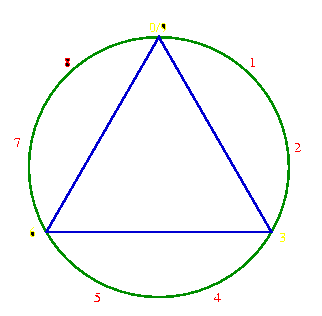
The nine points are the familiar nine points and the numbering used when discussing the enneagram. The points 1, 2, 4, 5, 7, and 8, are associated with particular endocrine glands and their corresponding functions, and it will be seen that the function of the gland becomes predominant at approximately the age assigned to each of those points, although it functions throughout our life. The points 0, 3, and 6, correspond to the external influences which are the food, breath, and light of a cosmos, and will be seen here to correspond to birth, speech, and sex, respectively.

How many pairs of rabbits will be produced in a year, beginning with a single pair, if in every month each pair bears a new pair which becomes productive from the second month on?
The answer is a numeric sequence that unfolds like this:
1, 1, 2, 3, 5, 8, 13, 21, 34, 55...and so on, each new number being the addition of the two previous ones. Among other features of this sequence is that the ratio of any two adjacent numbers approximates the golden mean with ever-greater exactness as the numbers get larger. So, for example, 13/8 = 1.625, while 21/13 = 1.615, where the result increasingly approaches the golden mean. (This also occurs in any numeric sequence in which the next number is created by adding the two previous numbers.) In the Fibonacci sequence, the quantities themselves appear in the growth of various natural organisms, for example, a sunflower may have 21 left and 34 right whorls.
It is well beyond my intent for this essay to go into any detail regarding the golden mean and the Fibonacci sequence. The use I want to make of this sequence here is in the first 10 numbers. As a sequence of natural growth, it must, of course, refer to human growth as well (Note 1).
Why this should be so is hard to say. Aside from making still another demonstration that both the enneagram and the Fibonacci sequence are meaningful, it also illustrates how human development is timed by years. That is, the Earth's revolution around the Sun, corresponding to our solar year, must synchronize the biological basis used to determine when a new human capacity should emerge. This is not to say that there is not some degree of individual variation—one individual reaching a stage before or after another. But, in general and to a remarkable degree, the Fibonacci numbers correspond to the development of stages expected by enneagram knowledge.

Modern science has recently determined that individual cells and more complicated structures of life have "biological clocks". The clocks under study—the ones I know of at any rate—are diurnal, that is, they time the length of the day. In general, if the cells under study are placed in certain artificial circumstances such as continual light or continual darkness, the clocks do not reset themselves accurately and may produce, for example, a 25 hour oscillation. But under normal conditions, and apparently profiting from a great deal of redundancy, the clocks correctly compensate for deviations and so continue to accurately time our days.
This has a range of practical uses which we are only beginning to guess. Certainly various endocrine secretions in our blood vary depending on the time of day and so on. We seem to also have some sort of clock that is timing the year—the year, the month, and the day all being natural rhythms the body is subject to.
We know a little about the monthly rhythm, for example a woman's menstrual cycle corresponds to this length, but in general the monthly rhythms remain uninvestigated and any mention of such possibilities is dismissed as "superstition". But we become less frantic when discussing, say, fish, and no one seems bothered to discover that a fish times its breeding cycles to correspond to the periods of the new and full moon. And, regarding the full moon at least, there are many such examples. The new moon, however, is much less investigated, mainly because it is invisible (I suspect that the new moon is Gurdjieff's "Anulios".) No "psychologist" will tell you that the moon affects human behavior, but any cop will (Note 2).
Annual rhythms have a similar obvious external nature and an unexamined internal nature. We know well the change of seasons, say, but only very recently has modern science related them to human psychology, for example in the relation of moods or emotion and the length of exposure to sunlight. This is essentially a whole new area of investigation, and promises to be interesting.

In the following paragraphs, I'll give a complete overview of this theory that relates the enneagram and Fibonacci sequence to our lifetime. Here is the figure I'll be discussing:
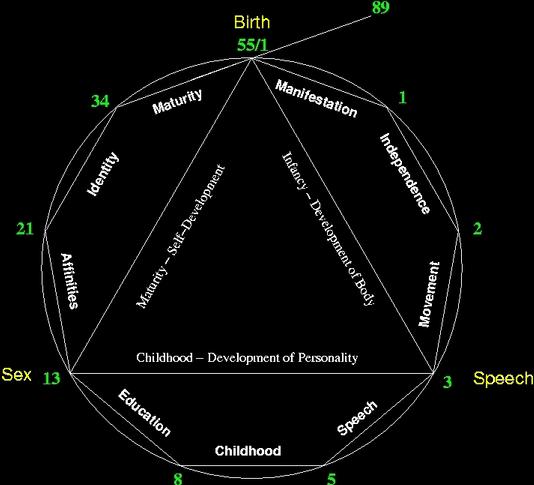
The figure is divided into three parts by the triangle, and these correspond to definite emphases in our life. The first third of the circle (moving clockwise from the top), concerns birth through the age of three. The emphasis here is on the development and basic use of our physical capabilities, ranging from getting the most simple motor control in order to eat, through walking, and finally talking. The development of speech becomes the means of entering the second third of our life, represented as the second third of the circle from the ages of 3 to 13 years. This is a time of the development of our basic set of social skills, our personality. It provides the necessary groundwork for the third stage of our life, here shown as the last third of the circle beginning at age 13. I have called this last third the age of self-development. It begins with the emergence of adult sexuality and proceeds from there. More on all of this when we talk about the nine stages in their three groups next.
It may seem strange here and throughout this essay to see these apparently unequal divisions called equivalent stages, but I take my cue from Rodney Collin, who pointed out the vast difference in time perception that occurs as we grow older. (Collin used a different scale, a logarithmic scale based on 10 lunations, to plot human development around the enneagram circle.) Everyone knows that common adult expression "time flies", but it doesn't fly for the child. The stages, as we move along the circle, enclose progressively more years yet contain an equivalency in experience and change.

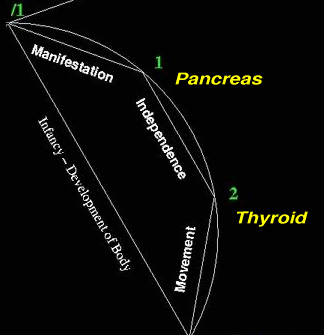
The two glands particularly associated with this phase of our life are the pancreas and thyroid, both of which "are derived from cells that arise in the embryonic digestive system" (Encyclopedia Brittanica).
The endocrine gland associated with 1 year is the pancreas, responsible for producing most of our digestive enzymes as well as a natural bicarbonate to neutralize any indigestion due to acidity. It is responsible for regulating the use of glucose, an important component of a mother's milk. Basically, the baby's job is to eat. Following the Fibonacci sequence, this stage would end at the age of one year.
The point designated by the age of two corresponds to the thyroid gland, the endocrine gland chiefly involved with metabolism and oxygen consumption. In other words, the thyroid is responsible for the proper burning of the fuel of our digested food, generating heat and other energies for our use.
And so the first "third" of life, infancy, is accomplished.


The basic idea to be discussed for this "third" of our life is the development of the personality, strictly speaking false personality, which is the socialization of the individual in our society. It is a necessary but not very pleasant accretion. This is normally the age of the fastest development of our emotional abilities. False personality develops as the result of our emotional sensitivities—we become so able to convey our emotions and perceive the emotions of others that we inevitably get hurt, and unconsciously find ways to protect ourself.
In this period is the age of five years and the endocrine gland spotlighted is the parathyroid (actually four closely-spaced glands). Parathyroid hormone encourages the use of calcium and phosphorus for bone growth in combination with the thyroid. Bone growth is an obvious necessity during these years of relatively rapid growth of the body.
Developmentally, both the thyroid gland and the parathyroid gland develop out of bronchial pouches (associated with lung development—this point is associated with breathing in the food diagram). Two of the four parathyroid glands as well as another gland, the thymus, both come from what is called the third bronchial pouch.
An aside: There is some association of the parathyroid with speech in that the thyroid/parathyroid interaction regulates the quickness of speech. My personal suspicion is that the thymus, the gland of pre-sexuality in general, is connected with the astonishing ability of children to learn language, but I find no support for this in the literature. But the thymus is clearly implicated in learning of another kind—the ability of our immune system to recognize viruses, once it has seen them, and this ability may be the fundamental cellular way in which we learn. I believe the thymus is implicated in learning in general. Curiously, or perhaps appropriately, in humans, the thymus type (solar) relative to all other types is naive. This seems contradictory, but it is interesting to me that learning is the central feature, or variable. Further thought leads me to believe that a certain naivete is implicated in learning in that a jaded "been there done that" kind of attitude is more closed to new possibilities than a naive openness and willingness to try something new. (See also Note 3 for more on the thymus and immune-system learning.) I mention the thymus even though it does not appear as a point on the enneagram circle—just as the solar type does not appear on the enneagram circle—because it is "the gland of childhood", decreasing in influence and even physical mass as we grow older.
The next two stages surround the point of the triangle I've associated with sex, the age of 13. The two points on either side of the point of sex are the ages of 8 and 21, associated with the adrenal glands and the posterior pituitary gland, respectively. The adrenal gland (actually two glands) is particularly associated with male sexual activity through the androgen hormones, an overproduction of which causes the condition known as virilism. The posterior pituitary produces oxytocin, a hormone responsible for the uterine contractions of childbirth and milk ejection during lactation.
The end of the second third of life is notable for the diminishing in size of the gland of childhood, the thymus, and the powerful emergence of sex. The particular glands associated with the point assigned "8" years here are the adrenal glands. These glands have multiple functions, including secretion of hormones to help deal with stress, and others related to sexuality, and are involved with the development of pubic hair and other early sexual characteristics in both males and females during the period just prior to puberty.
In addition, the adrenal cortex can synthesize the steroid hormones, including the progestogens and estrogens associated with female sexuality and the androgens associated with male sexuality. In general, girl's bodies start to change from the age of eight and later, and boy's bodies from the age of eleven and later. This is the beginning of puberty, leading us to the last third of the circle.

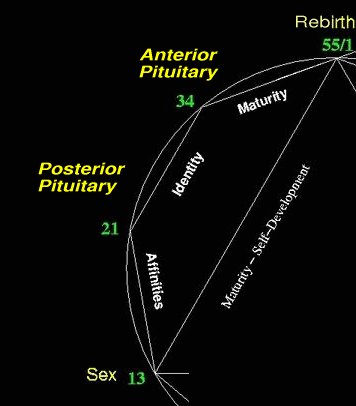
This third of our life, which I've called self-development, is characterized by our determining with varying levels of success who we are and what we want to be. The work of growth, for which the pituitary glands are primarily responsible, slows to completion in this period.
This stage corresponds quite closely with the developmental psychologist Erik Erikson's stage of "Adolescence", in which he discusses such ideas as "role confusion" and "identity crisis". The basic task here is determining who we are, what we want, and so on. Partly we do this by struggling against anything that would cast us in some role—no more "Momma's little boy"—and partly by aligning ourselves with interests and with others to whom we feel some affinity. Erikson considers the ideal result of this stage to be the arrival at a strong personal identity, the term I use to label the next stage.
The next two stages might be summarized as "parental". The two glands involved—the posterior pituitary and the anterior pituitary—are often simply referred to as "the pituitary" in the literature, but they really have very different functions.
The gland associated with the age of 21 is the posterior part of the pituitary. People in whom this gland is the predominant gland (i.e, people of this "type") tend to exhibit a strong sense of personal identity, and are easily offended, for example, if you forget their name.
In general, the type and its associated gland promote harmony between opposites.
Physically, we're not going to get any better than this. The endocrine gland associated with the point assigned the age of thirty-four is the anterior pituitary. It is sometimes called the "master gland" because most of its endocrine secretions influence other endocrine glands, rather than acting directly on cells. Because of our very arrival at this stage, the master gland has been successful in accomplishing our proper development through the endocrine system.
The anterior pituitary is, roughly speaking, a male counterpart to the more feminine functions of its partner, the posterior pituitary. For parents, the attitude shifts from the parental mothering of the previous stage to the more aloof paternal pattern (the children having become more independent and typically entering into the years associated with the adrenal and sex glands). Normal sexual desire gradually decreases as one of the anterior pituitary hormones (prolactin, the "parenting hormone") reduces testosterone production in men and has been implicated in loss of sexual desire and ability to conceive in women. For people who have become identified with their sexuality, this is an unnerving development.

Physically, our bodies are in decline. There are losses in hearing and vision, and in bone strength. While studies indicate our various endocrine glands remain capable of full production of their associated hormones, the fact is their secretions decrease. The cause or causes of this are not currently understood. One theory to account for this is that a decrease in secretions of the anterior pituitary, the master gland, would necessarily reduce the secretions of the glands it influences, but the miniscule quantity of anterior pituitary secretions makes this hard to determine, and in any case would not explain why the anterior pituitary itself has a diminished function.
Psychologically, we should continue to gain in wisdom, but that must be distinguished from a gain in knowledge. As, for example, scientific knowledge or cultural focus continues to change, we may be less and less aware of it, or interested in it. What becomes most important now is the quality of what we learned that has to do with eternal principles, rather than how much information we have accumulated about some temporal fascinations. More than knowledge now, what we need is being, and the profound integration of knowledge and being, which is understanding.
"Avoid studies that die with the student."
Leonardo da Vinci, Notebooks
On the circle of life, we have come full-circle, returning to the point called birth. Time to be born again, time for re-birth.

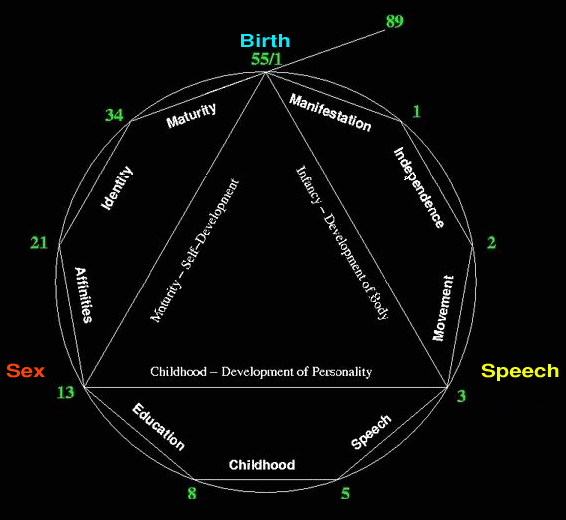

Note 2 - Lunar Influence See, for example, A recent scientific finding.. And note that this has nothing to do with the brightness of the moon.
Note 3 - Learning and Naivete The inextricable link between learning and naivete is well-illustrated by the function of the thymus gland, and even by the terminology scientists use to describe it. The thymus produces a hormone called thymosin, which causes the thymus's "immature" thymocytes (immune cells) to "mature". These cells (called T-cells) then go through "a remarkable maturation process sometimes referred to as thymic education" (see this site), in which they are selected for desirable behaviors. They are then released into the blood stream, where they are again referred to as "naive T cells" until they have encountered the specific target for which they were "educated". T-cells that encounter their targets and survive are called "memory" cells, able to respond to immune threats more quickly as a result of their experience.

All pages © Copyright John Raithel